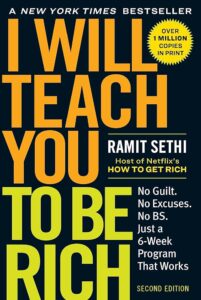
I Will Teach You to Be Rich: No Guilt. No Excuses. Just a 6-Week Program That Works (Second Edition)
Chapter 7: Investing Isn’t Only for Rich People
by DenzelleChapter 7 of Ramit Sethi’s I Will Teach You to Be Rich (Second Edition) dismantles the belief that investing is reserved for the wealthy or financially elite, presenting it instead as an opportunity accessible to everyone. Sethi emphasizes that with proper tools and knowledge, anyone can start building wealth regardless of their financial starting point. His relatable approach breaks down barriers of intimidation, making the complex world of investing approachable and actionable for beginners.
Sethi begins by simplifying investment principles like diversification and asset allocation, presenting them in digestible terms. He likens diversification to placing bets across multiple outcomes, reducing the risk of significant loss by spreading investments over various asset classes, including stocks, bonds, and cash. By translating these technical concepts into everyday analogies, he ensures that readers understand the importance of mitigating risks while maximizing potential returns. This practical explanation removes the intimidation often associated with financial jargon, encouraging readers to take their first steps into investing confidently.
The chapter introduces beginner-friendly investment vehicles, such as target-date funds, index funds, and mutual funds, tailored for long-term strategies. Target-date funds, for instance, adjust the balance between stocks and bonds automatically as investors near retirement, making them a simple, hands-off choice. Index funds, praised for their affordability and market-wide exposure, are presented as an ideal entry point for those seeking to diversify without excessive costs. By highlighting these accessible options, Sethi demystifies investing, showing readers that they don’t need to be financial experts to grow their wealth effectively.
One of the most powerful lessons in this chapter is the impact of compound interest, which Sethi describes as a force that can exponentially grow wealth over time. He explains how consistent, small investments can accumulate substantial value as interest compounds on both the principal and previous interest earned. By reinforcing the mantra that “time in the market beats timing the market,” he underscores the importance of starting early and staying consistent, regardless of market fluctuations. This focus on long-term investment removes the pressure to predict short-term market movements, encouraging disciplined, patient growth.
Sethi also champions automation as a tool to overcome emotional investing and procrastination. Automating investment contributions ensures regular deposits, removing the risk of forgetting or hesitating due to market anxieties. This hands-off approach not only simplifies the process but also instills a disciplined routine that drives steady financial progress. By eliminating decision fatigue, automation allows investors to focus on long-term goals while avoiding impulsive reactions to market volatility.
Dispelling common myths and fears, the chapter reassures readers that successful investing doesn’t require outsmarting the market or possessing advanced financial knowledge. Sethi advises against risky, speculative strategies, instead advocating for steady, informed approaches tailored to personal financial goals. He provides actionable steps, such as opening and managing Roth IRAs or 401(k)s and selecting funds that align with individual risk tolerance. This practical guidance empowers readers to start their investment journey with clarity and confidence.
The chapter also addresses market volatility, a source of anxiety for many new investors. Sethi normalizes market downturns, explaining that they are a natural aspect of investing and should not derail long-term plans. He emphasizes the importance of maintaining discipline during these periods, reminding readers to focus on their overall strategy rather than reacting to temporary market dips. By fostering resilience, he helps readers avoid impulsive decisions that could jeopardize their financial progress.
By the chapter’s conclusion, Sethi has not only demystified the fundamentals of investing but also inspired readers to take actionable steps toward building wealth. He reiterates that investing success is not about luck or financial expertise but rather consistent, informed action over time. With this empowering message, Sethi transforms investing from an intimidating endeavor into a practical and achievable goal for anyone willing to learn and commit to their financial future.
This comprehensive guide to investing is essential for readers seeking to take control of their finances. It combines clear explanations, practical strategies, and motivational insights to encourage active participation in wealth building. Sethi’s approach underscores that investing is not just a tool for financial growth but a means to secure a better future, making it accessible and relevant for all readers.


0 Comments